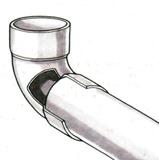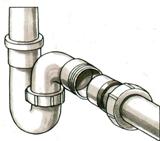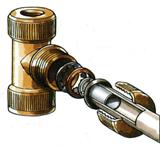DIY Heating Plumbing Tips 2 - Plastic Plumbing Design And Installation Guide
DIY heating plumbing tips 2 answers the following FAQ's on residential plastic plumbing pipes.
- What Are The Pipe Sizes?
- How Do I Connect Plastic Pipes?
- Can I Get All The Plumbing Joints And Fittings in Plastic?
- Are There Different Types of Plastic Pipes?
- Are Plastic Pipes Easier To Install Than Copper Tubing?
- Can I Connect Plastic Pipes To Copper Tubing?
- How Can I Cut Plastic Pipe So It's Square?
- What Is The Spacing Distance between the Pipe Support Clips?
What Are The Pipe Sizes?
The size of residential pipes is more or less standard but there can sometimes be slight variation in sizes between manufacturers.
The standard pipe sizes for residential homes are:
For general pipework (hot and cold services)
- 16mm or 15mm = (1/2in)
- 20mm or 22mm = (3/4in)
- 25mm or 28mm = (1in)
Overflow pipes
- 21mm = (3/4in)
Wash basin waste pipes
- 32mm = (1.1/4in)
Bath and sink waste pipes
- 40mm = (1.1/2in)
Soil pipes
- 100mm or 110mm = (4in)
How Do I Connect Plastic Pipes?
There are a number of methods you can use to connect plastic pipes depending on their use:
Solvent-Weld joints
- Solvent-weld joints are fused together by a chemical solvent (sometimes called liquid cement). It is a fast evaporating solvent that causes the two surfaces of the plastic joint to dissolve and fuse into one piece thereby sealing the joint.
- Even though solvent-welds can be used for supply pipes they are more commonly used for waste pipes

(the image above shows a plastic solvent joint)
- Be aware of the hazards of working with solvents. Ensure that there is good ventilation to the area of work when the solvent is being applied.
- Do not inhale the solvent fumes
- Do not smoke - fumes become toxic when inhaled through a cigarette
- Avoid spillage as the solvent can 'etch' pipework and certain other plastics
- Keep solvents away from children
Compression joints
- A compression joint is a threaded joint designed for easy dismantling, and is used to connect the 'Traps' (the water seal fitting) of baths, sinks, basins, and showers to the pipework. The integral rubber ring or washer makes this joint water tight

(the image above shows a plastic compression joint)
Push-fit joints for waste systems
- Because your waste system is never under pressure the pipe runs can be connected together with push-fit joints simply by pushing the plain pipe into the joint socket and the captive ring (an O-ring) inside the joint both holds the pipe in place and makes the joint water tight, e.g, the WC waste pipe connector (the connectors that connects to your toilet's waste pipe uses a similar method)

(the image above shows a plastic waste pipe push-fit joint)
Push-fit joints for supply systems
- With push-fit joints for supply systems, when the pipe is inserted an integral O-ring will seal the water. The grab ring or collet with stainless steel teeth (depending on the manufacturer) grips the tube and prevents the joint from coming apart under mains water pressure

(the image above shows a plastic tee push-fit joint)
- Pushfit joints are more obtrusive than a solvent-weld joint but they are quicker and simple to install



Press Fit Joints
- Press fit joints incorporate an outer metal sleeve. The body of the actual fitting can be either plastic or metal with integral inserts.
Depending on the type they are pressed together either manually or using a power tool
(the images above show a manually pressed plastic pipe press-fit joint)
Can I Get All The Plumbing Joints And Fittings in Plastic?
- Yes
- You can also connect copper to plastic and vice-versa.
Are There Different Types of Plastic Pipes?
Yes.
There is a range of different plastics that are used in residential plumbing such as:
Unplasticized polyvinyl chloride (uPVC)
- Unplasticized polyvinyl chloride (uPVC) is a hard and rigid plastic that is used for waste and cold water supply systems
Modified polyvinyl chloride (PVC)
- Modified polyvinyl chloride (PVC) is similar to uPVC but it is shock resistant because it is slightly more flexible than uPVC and also used for waste and cold water supply systems
Chlorinated polyvinyl chloride (cPVC)
- Chlorinated polyvinyl chloride (cPVC) is a much more versatile plastic. This plastic is suitable for hot and cold supply systems and can even be used in central heating systems
Polypropylene (PP)
- Polypropylene (PP) is a flexible plastic that has a greasy feel to it and is used for waste systems. This plastic however is never welded with solvent as it is impossible to glue PP
Polybutylene (PB)
- Polybutylene (PB) is another tough plastic which is used for hot and cold supply, and central heating (PB is able to resist bursting when frozen). You can get this plastic in standard lengths or coils
Cross-linked polyethylene (PEX)
- Cross-linked polyethylene (PEX) is used for hot and cold supply and underfloor heating systems. This type of pipe expands considerably when heated and tends to sag so is generally used laid flat so it can 'snake' when expanding
Multi layered Composite (MLC)
- Multi layered Composite (MLC) pipe is similar to PEX but it has an aluminium/aluminum oxygen barrier and does not lose it's shape like PEX pipe when heated
Medium-density polyethylene (MDPE)
- Medium-density polyethylene (MDPE) is more widely used for underground residential/domestic supply pipes as it can be laid in lengths and is resistant to pressure and corrosion
Are Plastic Pipes Easier To Install Than Copper Tubing?
- Yes
- Plastic pipes are easier and quicker to install than copper tubing and they eliminate any possible fire risk as there is no soldering or brazing of the joints
Can I Connect Plastic Pipes To Copper Tubing?
- Yes, you can
- You can use a special adapter coupling to connect most types of plastic pipe to copper and even galvanized steel pipes. If you are joining polybutylene (PB) to copper you can use a metal support sleeve called an 'insert' which is then inserted into the end of the plastic pipe over which a standard compression ring ( an olive) and locking nut is used to make tight and seal the joint

(the image above shows a plastic to copper connector)
Alternatively, you can join PB pipe to copper tubing using a push-fit or press-fit connector
How Can I Cut Plastic Pipe So It's Square?
- To cut the pipe square, rather than bevelled, simply wrap a piece of paper around it making sure that you align the edges and tape it in place. You can now use the edge of the paper as a guide

(the image above shows how to cut a plastic pipe square)
What Is The Spacing Distance between the Pipe Support Clips?
- See the table below for the maximum pipe support spacing measurements (meter), but check with the manufacturers' literature for the exact dimensions
Pipe size |
Copper- |
-tube |
Steel- |
-pipe |
Plastic- |
-pipe |
mm------------in |
horizontal |
vertical |
horizontal |
vertical |
horizontal |
vertical |
15 - 16: ---- 0.5 |
1.2 |
1.8 |
1.8 |
2.4 |
0.6 |
1.2 |
20 - 22: -- 0.75 |
1.8 |
2.4 |
2.4 |
3.0 |
0.7 |
1.4 |
25 - 28: ------ 1 |
1.8 |
2.4 |
2.4 |
3.0 |
0.8 |
1.5 |
32: -------- 1.25 |
2.4 |
3.0 |
2.7 |
3.0 |
0.8 |
1.7 |
40 - 42: ---- 1.5 |
2.4 |
3.0 |
3.0 |
3.6 |
0.9 |
1.8 |
50: ------------ 2 |
2.7 |
3.0 |
3.0 |
3.6 |
1.0 |
2.1 |
Got any good plumbing tips? |
Return To DIY Heating Plumbing Tips Page
Click here to visit online store.
Home Heat Loss Heat Gain Radiant Heat Central Heating Radiators UFH
Heat Pumps GSHP's WSHP's ASHP's Solar Heating PV Systems Boilers
Water Heaters Insulation Elec-Heaters
Terms of Use | Privacy | Contact Us

|
Visitors Say
Hi, My name is Shannon and I'm one of home-heating-systems-and-solutions.com readers. I'd like to thank you for the excellent information I've found on home-heating-systems-and-solutions.com, it's one of my favorite readings on the net. Warmest Regards Shannon United States
Thanks for the advice for removing an air lock from an indirect system. Had to change an inlet on my cistern. First time I have tried any home plumbing. After draining the cold tank system air locked when I refilled the tank. Garden hose and mains pressure up the tap sorted my problems. Would not have known what to do without the advice on the site. Many thanks Sean United Kingdom.
An excellent site. I have found it very usefull. I am currently in the design phase of a new house and have be pondering which heat system to use. From your site I have been able to choose the right system. Ross New Zealand
I enjoyed your site. Pat United States
We're so excited to announce our first Children Book
The Special and Talented Dog Show
To order click here
The second book published is called
Flying Things
This is aimed at a pre-school audience and is a rhyming story. You can buy by clicking here
To read more about our children's books, click here



